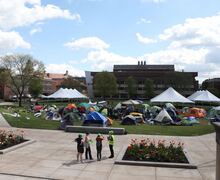Tomi Jacobs noticed a distraught female student waiting in a Hendricks Chapel hallway to speak with a chaplain. Though the student was not waiting for her, Jacobs, the Protestant chaplain, approached her anyway to help calm her.
The student, a freshman, had heard there was a suicide committed in her residence hall the year before and was unable to sleep because she worried the building was haunted.
“It was the rumor mill creating anxiety,” Jacobs said.
The student had heard about the suicide of Jordan Schaffer, a freshman who lived in DellPlain Hall in September 2008.
Schaffer’s suicide was the second of 14 student deaths since July 2008, the start of an unusually high death toll Syracuse University has experienced in the past year and a half.
University officials said death occurs in any large community like SU. But 14 deaths is still an unusually high amount, they said. The Counseling Center, as well as some chaplains at Hendricks, have seen an increased number of students seeking grief counseling relating to student deaths and have been adapting their counseling strategies to more proactively prevent suicide. The high number of student deaths has not affected the Student Affairs’ already strong immediate response protocol.
The Counseling Center has seen an increase in usage during the past two years, said Cory Wallack, director of the Counseling Center. In 2008, 4,871 students used Counseling Center services, as opposed to 4,546 students in 2007. The number increased again in 2009, but Wallack could not recall the statistics. Wallack also could not identify specifically if the increase was a result of students seeking counseling after a death, but he said there is an immediate influx of students coming to the Counseling Center each time there is a student death.
The most recent student death took place on Feb. 20, when Jamie Klemczak, a senior women and gender studies major, was killed by a hit-and-run driver while she was crossing the New York State Thruway in Herkimer County.
All but two of the deaths have been unrelated, therefore making 14 deaths unusual, said Thomas Wolfe, senior vice president and dean of student affairs.
The first death was Weixing Cai, who died in July 2008 when he fell from his apartment’s balcony. Matt Wanetik died while studying abroad in Strasburg, France, in October 2008. Alec Waggoner died in October 2008 after he was hit by an SUV while riding a bike in Thornden Park. The two related deaths were Oh Saem and Wang Young, who died in a car accident in November while driving to the New York City area for Thanksgiving. Nicholas Glagola died when a branch struck him while he was cutting down a tree in February 2009. John Morse died in June after he fell from the Irving Avenue parking garage. Kelly Farmer died in July after she fell, hit her head and drowned in Hiawatha Lake. Danny Facto died after a motorcycle accident in August. Stepan Dinis died of heart disease in January. In addition to Schaffer, there were three other suicides: Lisa Crowly, Gleidy Espinal and Christopher Wallace.
“I’ve never seen a thing like this,” Wolfe said. “Nobody has.”
Student Affairs, which spearheads the university’s response to a student death, has not changed its approach to responding to a death since the high number of deaths because it already has a strong protocol in place, Wolfe said. Because SU dealt with the loss of 35 students on the Pan Am 103 bombing in 1988, dealing with tragedy is engrained into the university’s culture, he said.
The high number of student deaths caused the Counseling Center to adapt by reaching out to potentially affected students faster and more thoroughly than in previous years, Wallack said, but it has not changed any protocols. The protocols include identifying any group who may be close to the student who died, holding meetings with those groups, offering individual meetings and making counselors available for 24 hours.
To prevent suicides and lower the number of student deaths, the Counseling Center is encouraging and teaching the university community to be more proactive in identifying at-risk behavior, Wallack said. It has resumed public service announcements on local radio stations about warning signs of suicide behavior and will be placing signs in the residence halls, advertising the Counseling Center and displaying warning signs.
Students usually have three distinct reactions to a peer death, Wallack said. Students close to the person who died show the seven stages of grief, other students experience grief triggered by a student death over the death of another person they knew and the third group of students seek counseling because they are facing mortality for the first time.
And although it is a very small number, some students have come into the Counseling Center overwhelmed by the high number of recent deaths, Wallack said, but the reaction to student death more typically experienced is students worried about their own mortality.
“Students are realizing they are not invincible,” Wallack said. “For many, they have never had anyone their age die. They start to think, ‘I’m vulnerable. I might die as well.’ Part of what we see is an increase in anxiety.”
Though the deaths are tragic, Wallack said, he does see a more positive byproduct — the strengthening of community.
“Obviously I don’t wish a death in our university community. That goes without saying,” Wallack said. “But one thing that I have noticed is that our community has become tighter, and when there is a death, it’s a positive experience to really see how students support each other.”
Gail Riina, the Lutheran chaplain, said she also has noticed an increase in the number of people seeking her counseling for grief after a student death. Some students have approached her with anxiety specifically because of the high number of deaths.
“I’ve experienced a little bit of people moving to the end of the world,” Riina said. “I think it’s a load. Part of it is just people don’t want to deal with the grief immediately, and they push it aside, so then it becomes generalized anxiety.”
With the death toll’s increase, Riina said, she believes the approach to counseling has become more personalized. When student deaths were rare, the whole university felt affected, Riina said. But as deaths became more frequent, those who were not directly affected were desensitized and ignored it, she said.
“I think that desensitization is in some ways more defensive,” she said. “I think we all feel it a little bit, but not the way we did in the beginning.”
The chaplains at Hendricks have been discussing leading a learning program about the stages of death and grief and how different religions cope with and honor death as a result of the high number of student deaths, Riina said.
Despite the claims that more students are facing their mortality, Jacobs, the Protestant chaplain, said she still feels students remain unworried. She said that for most students, life goes back to normal after a death unless they were personally affected.
“Despite the fact that 14 young people in the last year have died fairly easily, people who are between the ages of 18 and 25 still see themselves as immortal and that it’s not going to happen to them, and it just doesn’t take up too much of their thinking,” she said. “It’s a self-protection mechanism, I guess.”
Published on March 24, 2010 at 12:00 pm




